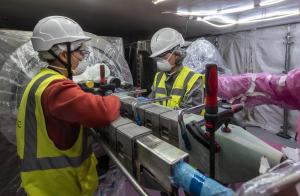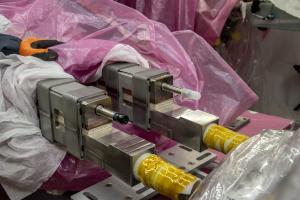Delivering the essentials
In the image above, workers from the CNPE consortium are finalizing the joints on the feeder connected to the lowest central solenoid module (CS2L). Their job consists in positioning high-pressure fiberglass panels around the finalized joint in order to form a "hard shell," or mold, into which epoxy resin will be poured to ensure electrical insulation.
¹Of the 31 feeders to be installed (21 at lower level, 10 at upper level), two are exclusively dedicated to instrumentation signals and three to the cooling of coil structures. All others carry current and coolant to magnets.
²The solutions that were developed for the joints bring their electrical resistance to an extremely low value—in the nano-ohm (nΩ) range. Despite this tiny amount of resistance and resulting small amount of heat generated, they can still be called "superconducting."
See also: H. Kim et al., "Progress on First-of-a-Kind Feeder Superconducting Machine Joints and Surrounding Structure Assembly in ITER Magnet System," in IEEE Transactions on Applied Superconductivity, vol. 34, no. 5, pp. 1-4, Aug. 2024, Art no. 4205104, doi: 10.1109/TASC.2024.3366158.
¹Of the 31 feeders to be installed (21 at lower level, 10 at upper level), two are exclusively dedicated to instrumentation signals and three to the cooling of coil structures. All others carry current and coolant to magnets.
²The solutions that were developed for the joints bring their electrical resistance to an extremely low value—in the nano-ohm (nΩ) range. Despite this tiny amount of resistance and resulting small amount of heat generated, they can still be called "superconducting."
See also: H. Kim et al., "Progress on First-of-a-Kind Feeder Superconducting Machine Joints and Surrounding Structure Assembly in ITER Magnet System," in IEEE Transactions on Applied Superconductivity, vol. 34, no. 5, pp. 1-4, Aug. 2024, Art no. 4205104, doi: 10.1109/TASC.2024.3366158.




